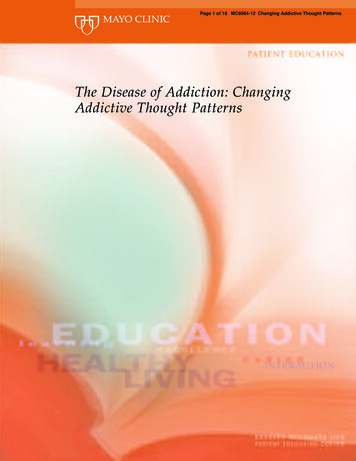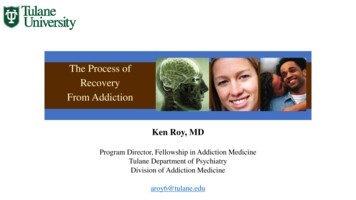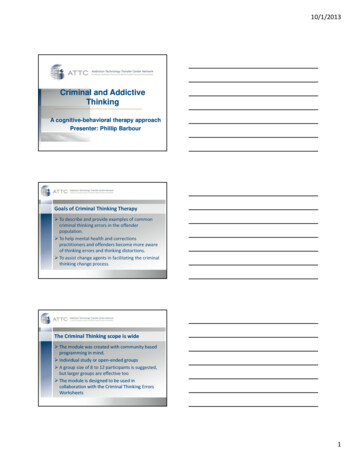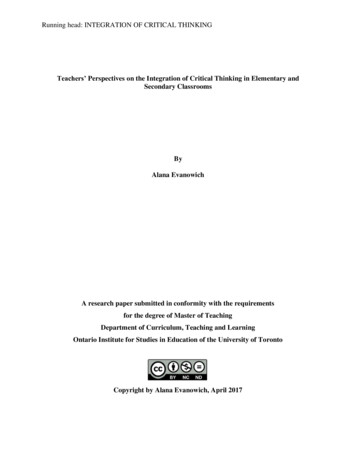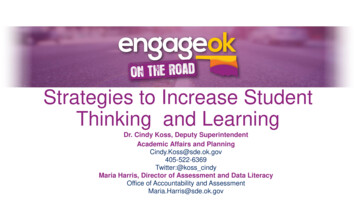
Transcription
Strategies to Increase StudentThinking and LearningDr. Cindy Koss, Deputy SuperintendentAcademic Affairs and koss cindyMaria Harris, Director of Assessment and Data LiteracyOffice of Accountability and AssessmentMaria.Harris@sde.ok.gov
Alignment to Learning Forward StandardsStrategies for Teaching and LearningThe new education law, Every Student Succeeds Act (ESSA), redefines professionaldevelopment with a purposeful influence from Learning Forward.Learning Forward, a national association recognized as leaders in professional learning,has established standards for professional learning that set a high bar for quality learningexperiences.This session aligns to the following standard(s): Learning Communities Professional learning that increases educator effectiveness and results for allstudents occurs within learning communities committed to continuous improvement, collective responsibility,and goal alignment. Learning Designs Professional learning that increases educator effectiveness and results for allstudents integrates theories, research, and models of human learning to achieve its intended outcomes. Outcomes Professional learning that increases educator effectiveness and results for all students alignsits outcomes with educator performance and student curriculum standards.
Understanding Depth of Knowledge (DOK)Teaching, Learning & Assessing at all LevelsESSENTIAL QUESTION: How does increasing the rigor in yourclassroom instruction and formative assessment enhance the learningof your students?LEARNING GOAL:Learn Ways to Apply Higher Order Thinking, Depth of Knowledge, andQuestioning Strategies to strengthen student learning.
Before we begin Critical Thinking is Important Activity: Take a minute and write why critical thinkingquestions are important.
Why are thinking questions important?Poll Everywhere – top four reasons 1. Increases student retention of knowledge, skills, and understandings.2. Fosters an active learning environment to maintain studentengagement.3. Stimulates students’ interest and curiosity in content.4. Helps students monitor their own understandings.5. Supports students in making conjectures and arguing validity.6. Allows students to hear different explanations by their peers.
Cognitive Rigor
Developing the Cognitive Rigor MatrixEducators use different models to describe cognitive rigor.Each addresses something different.Bloom –What type of thinking (verb) is needed to complete atask?Webb –How deeply do you have to understand the content tosuccessfully interact?Hess – Cognitive Rigor Matrix
Transitioning to More Rigorous Standards Implemented more rigorous science standards in 2014 Implemented more rigorous math and ELA standards in 2016 More rigorous assessments aligned to the new standards 2017 Demands more cognitive complexity in daily instruction
Anticipation Guide - DOKPoll Everywhere (Agree or Disagree)Note: Not all sentences are true!1. Depth of Knowledge (DOK) is about difficulty.2. DOK is about complexity.3. DOK is about what students are expected to know and be able todo related to complexity.4. DOK is about what follows the verb.5. DOK is a system for categorizing cognitive demand.6. DOK has four levels (recall, basic reasoning, strategic thinking,extended thinking).
What is DOK? DOK measures the degree to which knowledge is elicitedfrom students. DOK is a common language educators use to describe thecomplexity of learning tasks and test items.
Beginning at the BeginningWhat DOK is can best be explained by saying firstwhat DOK is NOT! DOK is not a verb. DOK is not about the “difficulty” of the task. DOK is not a grade-level indicator.
DOK Is About Intended Outcome,NOT Difficulty!DOK is a reference to the complexity of mentalprocessing that must occur to answer a question,perform a task, or generate a product.
DOK Is Not About DifficultyDifficulty is a reference to how many students answer a questioncorrectly.“How many of you know the definition of ‘exaggerate’?” DOK 1- recallIf all of you know the definition, this is an easy question.“How many of you know the definition of ‘vociferous’?” DOK 1 – recallIf most of you do not know the definition, this is a difficult question.
Same Verb – Three DOK Levels DOK 1-Describe three characteristics of metamorphic rocksRequires simple recall DOK 2-Describe the difference between metamorphic and igneous rocks.Requires cognitive processing to determine thedifferences in the two rock types DOK 3-Describe a model that you might use to represent the relationships that existwithin the rock cycle.Requires deep understanding of rock cycle and a determination of how best torepresent it.
DOK is About Complexity Level 1 requires students to use simple skills or abilities. Level 2 includes the engagement of some mental processingbeyond recalling. Level 3 requires some higher level mental processing likereasoning, planning, and using evidence. Level 4 requires complex reasoning, planning, developing, andthinking over an extended period of time.
DOK is About Complexity DOK focuses on complexity of content standards in order tosuccessfully complete a task or assessment. The outcome (product)is the focus of the depth of understanding. The intended student learning goal determines the DOK level. Instruction and classroom assessments must reflect the DOK levelof the objective or intended learning outcome.
DOK Review Choose 3 questions from the DOK cards. Identify the DOK level. Turn to your partner to discuss. Share with group.
HOW?How can strategies be used to developcritical thinkingfor teaching and learning?
STRATEGY CARDS SPAN LEVELS OFDEPTH OF KNOWLEDGE
VOTE VOTE WITH YOUR FEETStudents choose a response(strongly agree or agree or disagreeor strongly disagree)Students write the reason for theirchoice before moving to the cornerof the room for their choice.Interaction between students occursas they defend their position on anissue.Use as a pre-unit, mid-unit, or endof-unit learning activity.WHAT DOK LEVEL(S) AREPOSSIBLE IN THIS STRATEGY?
THINK/WRITE/PAIR/SHARETHINKWRITEPAIRTHINK
Student Response FormatsResponse Cards, Clickers, WhiteboardsClickers ProvideGame-Like AtmosphereQuick PollIf response cards were used instead of hand raising for just30 minutes per day, each student would make more than3,700 additional academic responses during the schoolyear.Immediate FeedbackOpportunity to DiscussMisconceptions or AcceleratePace of InstructionAnonymity to Classmates –Identified to the TeacherWHAT DOK LEVEL(S) ARE POSSIBLEWITH THIS STRATEGY?
ANNOTATE (Record of Thinking) I Agree & Know This? Raises a Question Connection* Interesting! ImportantEngaging work, work that stimulated their curiosity, permitted them to express theircreativity, and fostered positive relationships with others. It was also work at whichthey were good.How, then, would we define engagement? Perhaps the best definition comes from thework of Phil Schlecty (1994), who says students who are engaged exhibit threecharacteristics: (1) they are attracted to their work, (2) they persist in their work despitechallenges and obstacles, and (3) they take visible delight in accomplishing their work.September 1995 Volume 53 Number 1Strengthening Student Engagement: What Do Students Want (and what really motivates them)?Richard Strong, Harvey F. Silver and Amy RobinsonX DisagreeWHAT DOK LEVEL(S) ARE POSSIBLEWITH THIS STRATEGY?
Practice Annotating in ScienceA Mysterious Fungus Is Killing RattlesnakesIn the last two decades, fungal diseases have rapidly attacked populations offrogs, bats, and salamanders. The latest victims under siege are snakes, and ifsnake fungal disease isn’t stopped, researchers say it could yield disastrousresults.Snake fungal disease—caused by the pathogen Ophidiomyces ophiodiicola—is marked by skin lesions and thick blisters that can disfigure a snake’s faceand even prevent it from being able to eat, often leading to starvation.The outcome of the disease varies between species, but the mortality rate isespecially high in rattlesnakes, including the eastern massasauga rattlesnake.About 30 snake species have been found to be infected in at least fifteenstates in the United States, and many of the world’s 3,000 snake species arejust as vulnerable, said Jonathan Kolby, an American biologist andconservationist.By Hannah LangNATIONAL GEOGRAPHIC, June 12, 2017
Some General Tips If there is only one correct answer, it is probably level DOK 1 orDOK 2 DOK 1: you either know it (can recall it, locate it, do it) or you don’t. DOK 2: (conceptual) apply one concept, then make a decision beforeapplying a second concept. If more than one solution/approach, requiring evidence, it isDOK 3 or DOK 4 DOK 3: Must provide supporting evidence and reasoning (not justHOW solved, but WHY – explain reasoning). DOK 4: all of “3” use multiple sources or texts.
How Do We Develop Deeper Thinking? Making thinking apparent in everything you teach. Use Think Aloud strategy to model your thinking and metacognition. Include opportunities for students to “think aloud” with partners,small groups, and with the entire class. Encourage multiple responses or answers to the samequestion. Use questions in class and on assessments that requiredeep thinking and application.
Cognitive Rigor & Implications forClassroom Assessment Assessing only at the highest DOK level will miss opportunitiesto know what students do and don’t know – use a range; end “high” inselected/prioritized content. Performance assessments can offer varying levels of DOKembedded in a larger, more complex task. Planned formative assessment strategies and tools should focuson differing DOK levels.STRATEGY CARDS SPAN LEVELS OF DEPTH OF KNOWLEDGE
Reflecting on Your LearningWhat is one way you might apply these ideas in your work?THINK ABOUT What existing curriculum/formative assessment materials couldyou/your school use for a range of cognitive rigor? What classroom/instructional practices support the different levels ofDOK?
EXIT TICKET3-2-1 Exit TicketThree Things I Learned Today Two Questions One Comment on Presentation Today
Depth of Knowledge in English Language Arts
Depth of Knowledge in Mathematics
Depth of Knowledge in Science
Depth of Knowledge in Social Studies
Why are thinking questions important? Poll Everywhere – top four reasons 1. Increases student retention of knowledge, skills, and understandings. 2. Fosters an active learning environment to maintain student engagement. 3. Stimulates students’ interest and curiosity in conten




